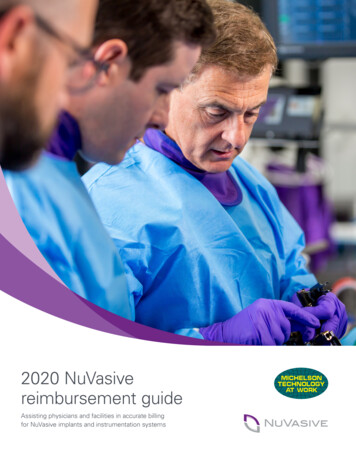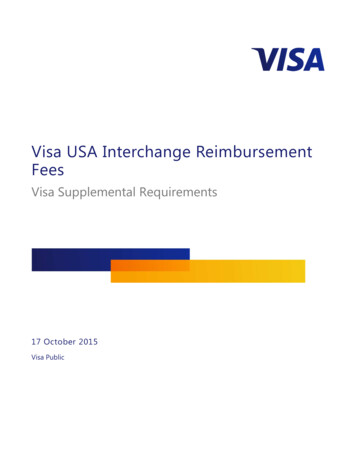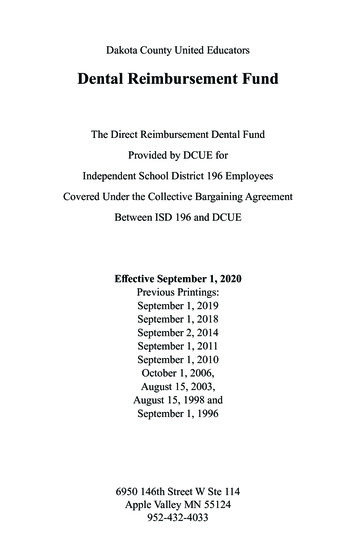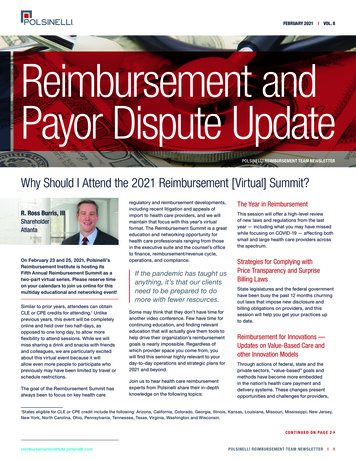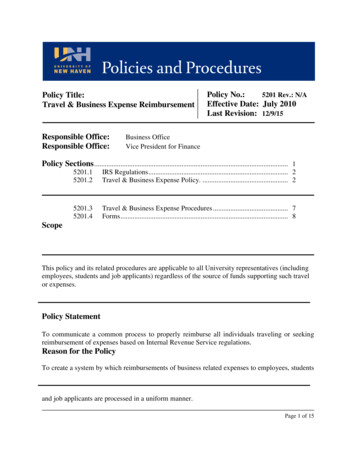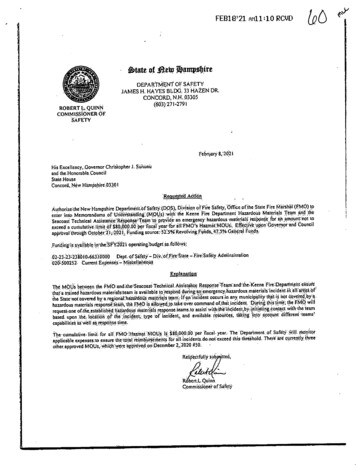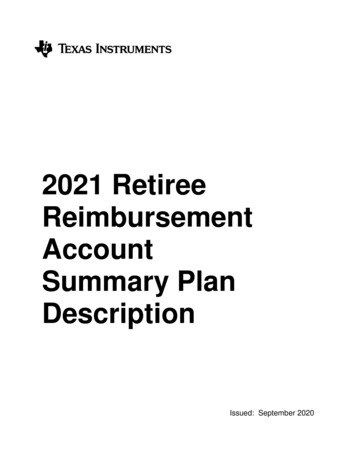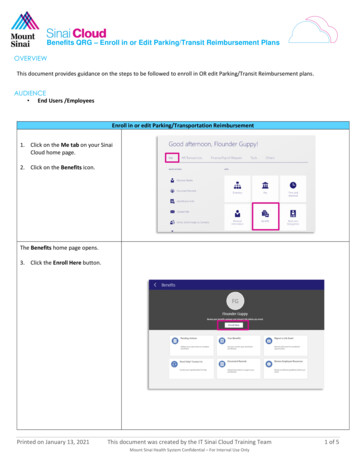
Transcription
A guide toReimbursementof Intermittent Catheters
Intermittent catheterization is a covered Medicarebenefit when basic coverage criteria are metand the individual or caregiver can perform theprocedure. Bard Medical provides this informationto help answer questions about coding andreimbursement for intermittent catheters.Disclaimer: The information in this document isinformational only, general in nature, and does notcover all payers’ rules or polices. This informationwas obtained from third party sources and issubject to change without notice as a result ofchanges in reimbursement regulations and payerpolicies.C. R. Bard, Inc. does not guarantee that use ofany of the codes noted in this booklet will ensurecoverage or payment at any particular level.Medicare, Medicaid or other payors may implementpolicies differently in various sections of thecountry. Physicians and hospitals should confirmwith a particular payor or coding authority, suchas the American Medical Association or medicalspecialty society, which codes or combinationscodes are appropriate for a particular procedure orcombination of procedures. Reimbursement for aproduct or procedure can be different dependingupon the setting in which the product is used.Coverage and payment policies also change overtime, so that information provided here may atsome point need to be revised.2
Coverage Criteria2Medicare considers an intermittent catheter as aprosthetic benefit—it’s purpose is to replace somepart of the body that is permanently inoperativeor malfunctioning. For this reason, the primarycriteria for Medicare coverage of Bard intermittentcatheters is that the individual have permanenturinary incontinence or urinary retention.Utilization Guidelines1Intermittent catheters are covered by Medicare asa prosthetic device benefit . Urinary catheters arecovered to drain or collect urine for a beneficiarywho has permanent urinary incontinence orpermanent urinary retention. Permanent urinaryretention is defined as retention that is not expectedto be medically or surgically corrected in thatbeneficiary within 3 months. For each episode ofcovered catheterization, Medicare will cover:One catheter (A4351, A4352) and an individualpacket of lubricant (A4332); orOne sterile intermittent catheter kit (A4353) ifadditional coverage criteria (see page 4) are met.3
1Intermittent catheterization using a sterileintermittent catheter kit (A4353) is covered whenthe beneficiary requires catheterization and thebeneficiary meets one of the following criteria (1-5):1. The beneficiary resides in a nursing facility.2. The beneficiary is immunosuppressed, forexample (not all-inclusive): on a regimen of immunosuppressive drugspost-transplant on cancer chemotherapy has AIDS has a drug-induced state such as chronic oralcorticosteroid use3. The beneficiary has radiologically documentedvesico-ureteral reflux while on a program ofintermittent catheterization,4. The beneficiary is a spinal cord injured femalewith neurogenic bladder who is pregnant (forduration of pregnancy only),5. The beneficiary has had distinct, recurrenturinary tract infections, while on a program ofsterile intermittent catheterization with A4351/A4352 and sterile lubricant A4332, twice withinthe 12-month prior to the initiation of sterileintermittent catheter kits.A beneficiary would be considered to have aurinary tract infection if they have a urine culturewith greater than 10,000 colony forming units ofa urinary pathogen AND concurrent presence ofone or more of the following signs, symptoms orlaboratory findings: Fever (oral temperature greater than 38º C[100.4º F]) Systemic leukocytosis Change in urinary urgency, frequency, orincontinence Appearance of new or increase in autonomicdysreflexia (sweating, bradycardia, bloodpressure elevation) Physical signs of prostatitis, epididymitis,orchitis Increased muscle spasms Pyuria (greater than 5 white blood cells[WBCs] per high-powered field)4
Documentation Requirements3To begin the claims process and get yourintermittent catheter supplies, you’ll need a doctor’sorder or prescription. Be sure this documentationincludes the following: Beneficiary’s namePrescribing provider’s nameDate of the orderDetailed description of the item(s)Frequency of usePrescribing provider’s signature and dateIn cases where quantity used each month exceedsthat originally prescribed by your doctor, youmay need additional documentation to ensurereimbursement. A pharmacy or medical suppliesdealer should be able to help you get medicalrecords that indicate this need due to permanenturinary incontinence or urinary retention.Categories and Healthcare Common ProcedureCoding System (HCPCS) CodesIntermittent catheters are classified into genericdescriptive categories and are assigned analphanumeric code. These HCPCS codes are usedwhen billing for your catheter supplies.HCPCS Description1 A4351 Intermittent urinary catheter; straighttip, with or without coating (teflon, silicone,silicone elastomer, or hydrophilic, etc.), each A4352 Intermittent urinary catheter; coude(curved) tip, with or without coating (teflon,silicone, silicone elastomer, or hydrophilic,etc.), each A4353 Intermittent urinary catheter, withinsertion supplies A4332 Lubricant, individual sterile packet,eachThe following table represents the usual maximumnumber of supplies:Code (#/mo)A4332 (200)A4351 (200)A4352 (200)A4353 (200)5
Frequently Asked QuestionsHow many intermittent catheters does Medicareallow?1Medicare will reimburse for up to 200 intermittentcatheters per month, according to April 1, 2008guidelines. Intermittent catheters are designed tobe used only once and then discarded.Should I expect to get 200 of each supply everymonth? Medicare’s policy shows a table listing a“usual maximum” of 200 for number of suppliesallowed.1No, you probably won’t need that many. Medicare’s“usual maximum” number is for patients withextreme utilization requirements. Most people willnot require 200.Your doctor will make a determination, based onyour medical condition, about how many suppliesyou’ll need. Medicare requires sufficient informationin your medical record to justify the amountordered.You or your caregiver must request refills ofurological supplies before they are dispensed.Suppliers cannot automatically dispense apredetermined amount of supplies on a monthlybasis. Instead they should check with you or yourcaregiver to find out how many you’ve used to dateand adjust the number of supplies accordingly.What if I need more supplies than the usualmaximum listed in the Medicare guidelines?1Your doctor will need to provide a writtenexplanation for why you need more. This letterwill be kept on file by your supplier. If you havea history of symptomatic recurrent urinary tractinfections while using intermittent catheterization,you’re eligible for a higher quantity of catheters orcatheter kits with insertion supplies.What can I do about recurrent urinary tractinfections? I’ve started using straight intermittentcatheters, but they don’t seem to help.1Talk with your doctor and see if a closed systemintermittent catheter might help. It’s a “touchless”6
catheter, meaning your hands do not have to touchit, reducing the risk of infection. Medicare coversthese under an A4353 HCPCS code. They do requireadditional documentation.My medical costs are covered by my privateinsurance policy, not Medicare. Will Medicare’spolicies affect me?Check with your insurance company to be sure.Most insurance providers do follow Centers forMedicare and Medicaid Services (CMS) guidelines.My doctor says I require a coude tip catheter, sinceI’ve been unable to catheterize using a straight tip.Do I need to provide additional documentation tobe covered?1Yes, Medicare requires that your medical history filebe documented to show need for a coude tip. Yourdoctor will need to document that you’re unable topass a straight tip catheter, or that you suffer fromurethral strictures that make catheterization moredifficult.According to Medicare guidelines, a coude tip isnot usually medically necessary in female patients,but women who are unable to pass a straight tipcatheter are usually covered for use of a coude tipcatheter. For women who are just learning to useintermittent self-catheterization, some healthcareproviders have found that an olive tip coude may beeasier to use.What information does Medicare require in anaudit to cover payment for the type and quantityof urological supplies ordered by my doctor?1Your medical record must contain documentationof your medical condition that proves the typeand quantity of items ordered are needed atthe frequency of use or replacement ordered byyour doctor. For intermittent catheterization, theinformation should include: Prescription Medical Record Information (includingcontinued need/use if applicable) Correct Coding Proof of Delivery7
Your medical record must include all clinicalinformation necessary to support the medicalnecessity for the item. It should be furthersubstantiated by a supplier-prepared statementor physician attestation. But neither your doctor’sorder or attestation, nor a supplier-preparedstatement alone is sufficient documentation ofmedical necessity.In addition to your doctor’s office records, yourmedical record may include hospital, nursing home,or home health agency (HHA) records, and recordsfrom other professionals including, but not limitedto, nurses, physical or occupational therapists,prosthetists, and orthotists.If my supplier bills Medicare directly, do they alsotake my co-pay?Yes. If your supplier accepts assignment forMedicare, you will need to pay the supplier 20% coinsurance of Medicare’s allowable amount for yourproduct. If your supplier doesn’t accept assignment,they are still required to file your claim. Uponreceipt of the claim, Medicare will pay its portion ofthe cost directly to you. The supplier may requireyou to pay most of the entire bill when you receiveyour supplies.What can I do if my supplier tells me my cathetersare not covered? They’re saying I have to pay forthem.Intermittent catheters are covered under Medicareand there are many suppliers who can help you getcoverage and reduce your out-of-pocket expenses.Where is the best place to get my product if Idon’t have insurance?You may be able to find lower prices on yourproduct through a cash-based supplier. Since thesesuppliers avoid the administrative expenses of filinginsurance claims, they can usually provide the sameproduct for less money.8
I’m having trouble getting my Bard brand ofcatheters. What can I do?Please contact Bard Care at 1-800-243-3315 orwww.bardcare.comWho can I contact with further questions?Please contact Bard Care at 1-800-243-3315 orwww.bardcare.com9
Notes:10
Notes:11
A guide toReimbursementof Intermittent Catheters1.Local Coverage Determination (LCD):Urological Supplies (L33803).Centers for Medicare & Medicaid Services2.Local Coverage Article:Urological Supplies - Policy Article (A52521)Centers for Medicare & Medicaid Services3.Local Coverage Article:Standard Documentation Requirements for All ClaimsSubmitted to DME MACs (A55426).Centers for Medicare & Medicaid ServicesIntermittent catheters are intended for draining urine from thebladder. Reuse of a single use device may create a risk of patientor user infection. Please consult product labels and inserts formore detailed safety information and instructions for use.C. R. Bard, Inc. Covington, GA 30014www.bardcare.comBard is a registered trademark of C. R. Bard, Inc. 2017 C. R. Bard, Inc. All Rights Reserved. Printed in U.S.A.1702-13 BMD/INCA/0917/0176
Medicare considers an intermittent catheter as a prosthetic benefit—it's purpose is to replace some part of the body that is permanently inoperative . Change in urinary urgency, frequency, or incontinence Appearance of new or increase in autonomic dysreflexia (sweating, bradycardia, blood
